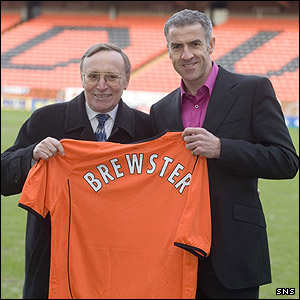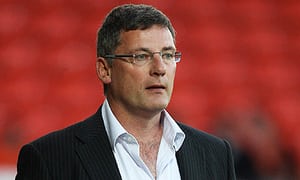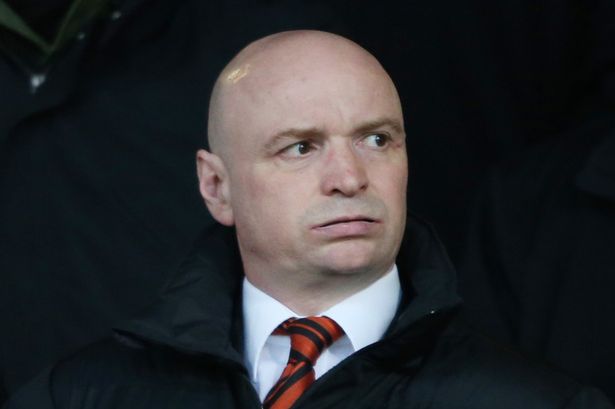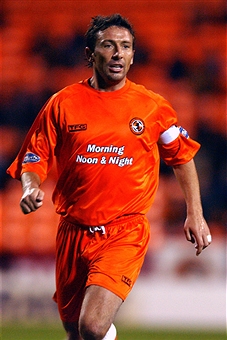And so another manager departs Tannadice. Of course, every Dundee United supporter wishes success for anyone who steps into the Tannadice managerial hotseat. But with Ray McKinnon the desire was extra strong amongst Arabs. And not just because the timing and circumstances surrounding his appointment made it imperative that he became a success. McKinnon was, and remains, one of our own. A Dundee laddie and a proud Arab, he was always one of those players who was more than happy to give you the time of day. Any United supporter who has spoken to him since he took over at Tannadice would confirm his good guy credentials are as strong as they ever were.
In that regard, there are strong echoes with another United managerial appointment in recent years. Nobody needs an education on what Craig Brewster means to United supporters. The hero of ‘94 was given a fitting welcome when he returned to the club in 2006 and, like McKinnon, has always been known as an affable and approachable figure among Arabs.

And the similarities don’t end there. Both arrived during tumultuous periods for the club. Back in 2006, Eddie Thompson, although only in the door as United chairman for three and a half years, had already earned himself a reputation as being one of Scottish football’s most ruthless owners. Brewster was the sixth manager of Thompson’s short time in charge. This continual chopping and changing in the dugout had unsurprisingly garnered poor on-field performances.
For all the incessant talk of budgets and spending power, it’s actually clubs who operate on a stable basis, both on and off the park, who more often than not perform better than those who continually change personnel.
A cursory look at any success stories in Scottish football over the years demonstrates this.
In recent times, St Johnstone under Tommy Wright have had stability coursing through every fibre of the club. When they won the Scottish Cup in 2014, it seemed like the core of that squad had been plying their trade in Perth since time immemorial Yet, three years on, the bones of that team still holds. And still continually punches way higher than the wisdom of budgets says it should.
At Celtic, when Brendan Rodgers arrived last summer, he was shrewd enough to see that only very slight alteration of the core Ronny Deila’s Celtic team was required to continue their dominance of the Scottish game. Tweaks, rather than a wholesale makeover was sufficient. Would an unbeaten domestic campaign and a treble have been achieved after a radical makeover? With a man of Rodgers’ astuteness in charge, it is entirely possible. But what is certain is that the familiarity among the core of that Celtic team allowed Rodgers to hit the ground running and avoid any transitional ‘bedding in’ period.
And at Dundee United, we know better than anyone that stability and continuity is the secret to success. The greatest period in the club’s history was built on the foundations of just two managers over a 34 year period. Leaving aside the tired jokes of long contracts, under Jim McLean, Dundee United was a club where players wanted to stick around. Player turnover was remarkably low. Clearly, this stability both on and off the park had a huge bearing on the club’s success during this period.
Back in 2006, when Brewster’s ten month stint in the Tannadice dugout sadly ended in similarly predictable circumstances as his predecessors, United seemed as far away as is possible from stability. Mercifully however, the club happened upon Craig Levein. Here was a one man coach, manager and director of football. Although Eddie remained the ceremonial head of state and signed the cheques, it was Levein who pulled the strings within Tannadice. He assumed overall control and changed the mindset of the entire club in his own image almost overnight. Stability ensued because Dundee United became a dictatorship. Levein built solid foundations which would last long after he had departed. Thus the stewardships of Levein, Houston and the first half of the McNamara reign became the period of stability and success in the Thompson era.

Unfortunately this seven year period of relative success and on field stability has been bookended by spells of instability bordering on chaos. The hire and rapid fire policy has worryingly returned to Tannadice in recent years. And again, on field performances have suffered accordingly.
One of the many ways in which foreign football differs from Scotland is the role of the sugar daddy chairman. A club can sometimes make up for instability on the playing side simply by buying the best players. Mourinho’s first season at Chelsea under the free spending Abramovich being a stand out example. Similarly this season, Paris St Germain seem to be making a good stab at blowing the competition out the water with a cheque book.
Ironically, one of the last of this breed in Scotland was Eddie Thompson. Although clearly not in the league of the Qatari billionaires and Chinese consortiums that now populate the global elite, Thompson Sr. was always quick to write a cheque to plug the gap when on field performances threatened a calamitous outcome. Which is just as well really, given his complete inability, or at least unwillingness, to deal with the club’s debt throughout his tenure. Despite repeatedly warning at every opportunity that Dundee United must become financially solvent (although always more forcefully when it was time to renew season tickets, oddly enough), the club remained a financial basket case during the entirety of his tenure.

And so it has continued with his son. Thompson Jr. echoes all the same dire warnings as his father. Yet he has run an operating loss every single year since his takeover. The crucial difference between the two Thompsons though, is that whilst Eddie could help to stave off any real danger and so mask his inability by repeatedly dipping into his own personal wealth, Stephen has no such riches behind which to retreat. Luckily for him though, just as the cheques stopped being written, a generation of players came through at the club who could be exchanged for some desperately needed cash.
And since then, Stephen’s strategy to cover these financial black holes has been to sell on the club’s best players; that is to actively pursue a policy of instability and disruption.
In this regard he has been quite open. Income from player sales isn’t viewed as an occasional bonus which can be reinvested when it comes along; it is necessary for the club to survive.
Not only does this disrupt any prospect of stability and continuity on the park, it also makes progress almost impossible. Take Nadir Ciftci for example. A largely inexperienced player that was plucked from lower league Dutch football. Something of a gamble. Probably a 3/1 shot. Thankfully, it was a gamble that paid off and Ciftci was a huge success during his time at the club. So, in line with the club’s policy, he became the next player to cash in on. Very few among the United support could blame Ciftci for moving to Celtic, nor Thompson for accepting what was a rather generous offer for a player about to enter the final year of his contract.
The issue was what came next. Rather than dishing out an appropriate budget to give the best opportunity of finding an able replacement, the transfer income was swallowed up by debt repayments and the manager was left to take another punt on another largely untried player. Any gambler will tell you that if you continually stick your money on 3/1 shots, it won’t be long before you’re empty handed. £1.5 million will always be good value for a player sale in the world of Dundee United. But what does it matter if it’s £1.5 or £15 million when the money left over gets you Darko Bodul?
By then however, what had begun as a manageable trickle of players making their way out the door, had become a stampede. Once it became clear that Dundee United wasn’t a club where good players hung around for long, nobody wanted to be the one left behind.
Since John Souttar broke into the first team at 16, he spoke maturely, and in clear terms, of his plan for his career. He would learn his trade at Tannadice, play around 150 first team games, before progressing to the next level.
Before he’d reached even half that number of games however, Souttar had seen his teammates sold off at an alarming rate and so, seeing that Tannadice was no longer the place for him to progress, he too went out through the exit. It’s worth bearing in mind here that when Souttar went, it wasn’t for the riches of England, but to Hearts. He clearly still had the same career plan, but a club with the transfer policy of Dundee United was no longer the place for him to fulfill it.
And yet despite the many millions raked in from transfers in the past few years, the situation at the club has gotten steadily worse.
Compare all this with Aberdeen and the success they have enjoyed in recent years, built on a foundation of stability on and off the park.
In March this year, Dons manager Derek McInnes informed the media that Peter Pawlett would be leaving the club when his contract expired in the summer. McInnes was disappointed, he said, because Pawlett would be the first player to leave during his time in charge at Pittodrie that he had wanted to keep at the club. That is an incredible statistic, given the success Aberdeen have enjoyed in the four years since McInnes arrived at the club.
Several players in McInnes’ time have been linked with moves away but the club managed to resist so many approaches, firstly because they weren’t reliant upon the financial boost of a transfer fee. But also, because the players were happy at a club where they had been allowed to grow and become successful together.

Aberdeen’s success under Derek McInnes merits special mention here. Back in 2013 when Peter Houston left United, McInnes was interviewed for the manager’s job at Tannadice. In the end, Thompson opted for McNamara and a few months later, McInnes ended up at Aberdeen. Given the fact that both clubs were very much on an even keel at that time, it does present a ‘What if?’ moment. Had Thompson gone for McInnes, would it instead be United at the top end of the league, consistently fighting out with Celtic for major honours?
The answer to this however is pretty straightforward: with Thompson as chairman, almost certainly not.
As manager of Dundee United, instead of building the solid foundations he has shown himself so capable of, McInnes would have been forced to continually sell his best players in order to stem the outpouring of financial lunacy in the boardroom.
Now, with United now looking for yet another manager, the question must be asked: for as long as Thompson is chairman, does it really matter who comes in next? Could any manager put in place the necessary framework to make a success under this chairman and his woeful lack of fiscal control?
The bottom line is clear. Over the course of a decade and a half, the Thompsons have utterly failed to get anywhere close to dealing with Dundee United’s debt and running the club in a financially prudent manner. This is despite stating repeatedly that this is where the club must operate. The damage this has caused the club during that time is plain for all to see.
It is now well past time for Thompson to admit he isn’t up to the job in hand and to pass the club over to someone who is.
